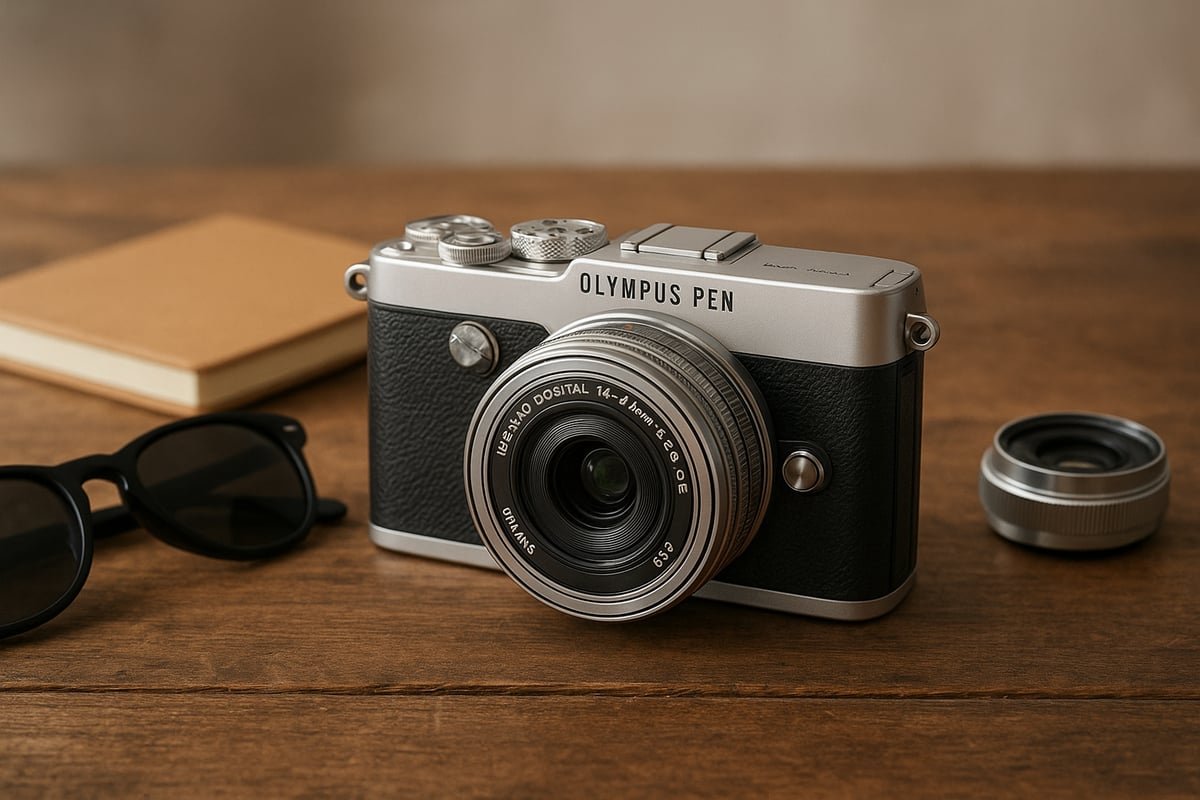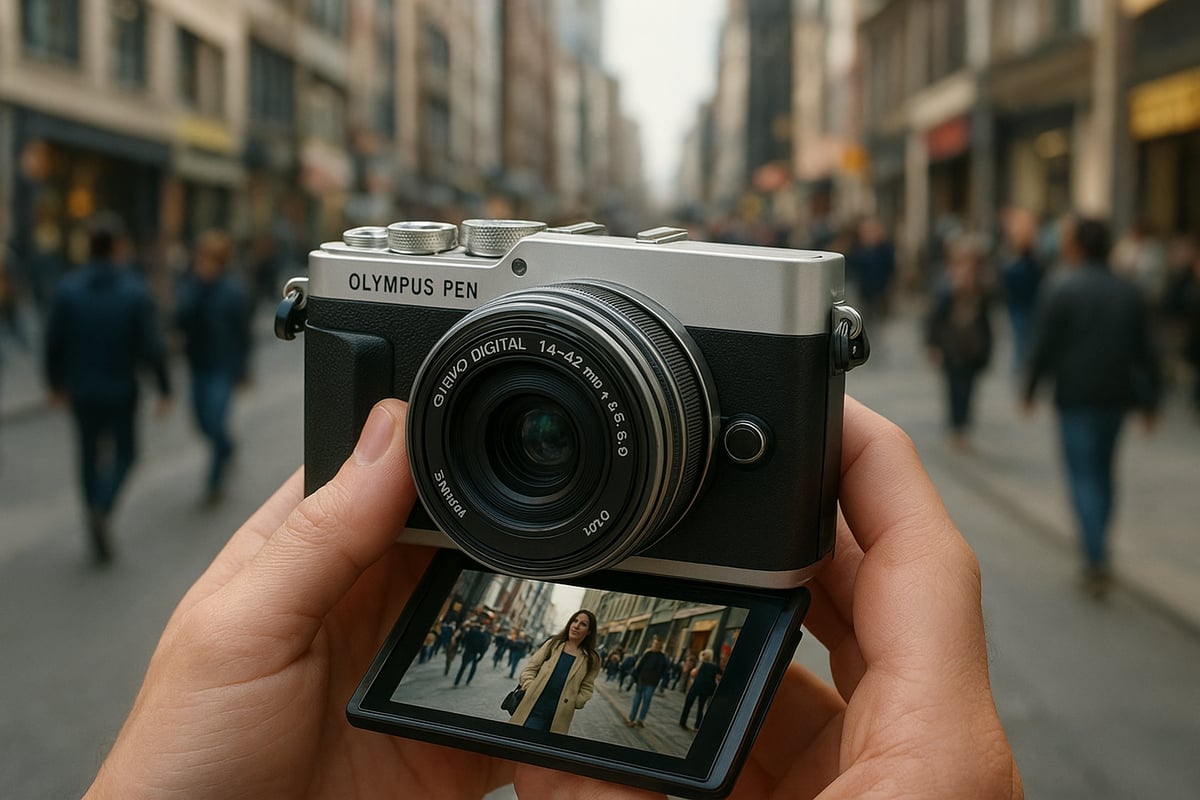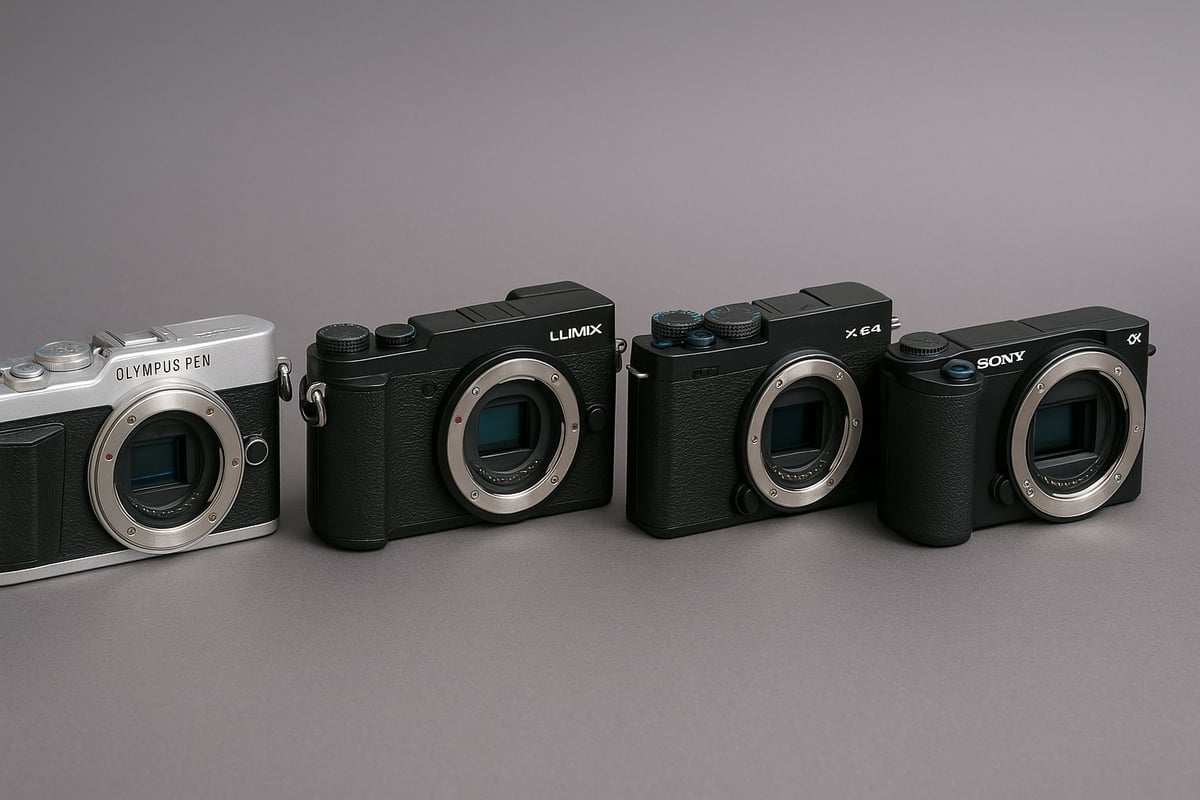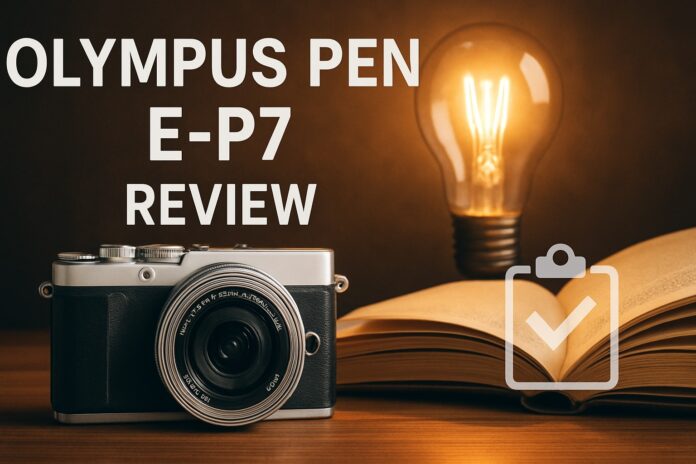Compact mirrorless cameras continue to capture the imagination of photographers in 2025, blending portability with ever-advancing technology. If you are searching for an expert olympus pen e p7 review, you are in the right place. This guide delivers a hands-on perspective, perfect for anyone considering the E-P7 as their next creative companion.
In this review, you will discover insights into the camera’s design, image quality, performance, and real-world handling. Expect clear comparisons to rival models and honest advice on who will benefit most from the E P7. Ready to find out if this stylish, capable camera fits your photography journey? Let’s dive in.
Contents
Olympus Pen E-P7: Design, Build, and Ergonomics
The Olympus Pen E P7 stands out in the world of compact mirrorless cameras, not just for its performance but for how it feels in your hands and fits into your daily life. As someone who values both form and function, I believe design and ergonomics are just as crucial as specs. Let us dive into the details that make this camera a favorite for on-the-go creators.

Retro-Inspired Aesthetics and Modern Touches
The Olympus Pen E P7 instantly catches your eye with its retro-inspired design. Its slim profile and brushed metal accents evoke the golden age of rangefinder cameras, making it a stylish companion for any outing. When holding the camera, the tactile dials and customizable buttons feel responsive and precise, which is a pleasure for those who like to adjust settings on the fly.
Handling is excellent thanks to the textured grip and thoughtful button placement. Compared to other compact mirrorless bodies in its class, the E P7 feels robust without being heavy. At just 337 grams with battery and card, it is lighter than many rivals, which is a big advantage for travel or street shooters. Color choices include a clean silver-black and a chic all-black, appealing to both classic enthusiasts and modern minimalists.
Durability is solid for daily use, though it lacks full weather sealing. In field tests, it handled city dust and the occasional splash with no issues, but I would be cautious in heavy rain. For those curious about how the build compares, check out the Best mirrorless cameras for 2025 for a side-by-side look at weight and material stats. Overall, the olympus pen e p7 review shows this camera balances vintage charm with modern reliability.
LCD, Viewfinder, and Interface Usability
One highlight in the olympus pen e p7 review is the tilting LCD, which flips up and down for flexible shooting. Whether you are vlogging, composing low-angle street shots, or capturing candid moments, the screen’s articulation is a real asset. The lack of a built-in viewfinder may deter some purists, but in practice, the bright 3-inch display is crisp and responsive, even in daylight.
Navigating the menus is straightforward, with Olympus’s latest interface updates making it easier than ever. The touchscreen is quick, and the customizable quick-access controls mean you can set up the camera to match your shooting style. Compared to previous Olympus models, menu organization has improved, reducing the learning curve for new users. Feedback from first-time users and seasoned photographers alike points to a comfortable and intuitive experience.
For those who like to tweak every setting, the customizable buttons and MyMenu options are a welcome touch. In busy street scenarios, I found it easy to change ISO or focus modes without missing a shot. LCD specs compare well with competitors in 2025, offering good resolution and visibility for real-world use.
Lens Compatibility and System Flexibility
A key strength in any olympus pen e p7 review is the flexibility of the Micro Four Thirds mount. The E P7 opens access to a huge ecosystem of compact, lightweight lenses. For travel, the 14-42mm pancake zoom is popular, while portrait shooters often reach for the sharp 45mm f1.8. Street photographers like myself appreciate the small 17mm or 25mm primes for discretion and image quality.
Compatibility with legacy Olympus and Panasonic glass means you can find affordable options on the secondhand market. Autofocus performance remains snappy even with most third-party lenses, although some older models may focus a bit slower. The system’s size and weight advantages are significant, especially when you want a full kit that fits in a small bag.
Lens availability remains strong in 2025, with plenty of budget and pro-grade options. The creative versatility, from ultra-wide to telephoto, is impressive for such a compact system. Compared to rival mounts, Micro Four Thirds offers more compact lens choices, making it easy to build a travel-friendly setup.
Battery Life and Connectivity
Battery performance is a practical concern in any olympus pen e p7 review. In real-world shooting, I consistently got around 350 shots per charge, which matches the CIPA rating and is competitive for this class. While not the longest-lasting, it is enough for a day’s casual shooting or an afternoon of street photography.
USB charging is a lifesaver, letting you top up on the go with a power bank. Wireless transfer is quick, and both Bluetooth and Wi-Fi connections remain stable for mobile workflows. The E P7 supports remote control via the Olympus app, making group shots and self-portraits easy.
The single SD card slot supports fast UHS-I speeds, which is sufficient for most users. For those looking to maximize battery efficiency, turning off Wi-Fi when not in use and lowering the LCD brightness helps stretch a charge. Charging times are reasonable, and carrying a spare battery is always a smart move. Connectivity is improved over prior models, making the E P7 a modern, mobile-friendly companion.
Image Quality and Sensor Performance
Getting to the core of any olympus pen e p7 review, image quality and sensor performance are what truly matter to photographers. Whether you shoot landscapes, portraits, or street scenes, the E P7’s capabilities in these areas define the camera’s real-world value. Let’s break down what you can expect from this model in 2025.

Sensor Technology and Image Output
The Olympus Pen E P7 uses a 20MP Live MOS sensor, which strikes a balance between detail, dynamic range, and manageable file sizes. In practical terms, the sensor delivers crisp images with excellent color accuracy, especially in JPEG mode. Olympus’s color science shines in skin tones and vibrant scenes, making the E P7 a strong contender for travel and portrait photography.
Photographers will appreciate the flexibility of RAW files, which allow for significant adjustments in post-processing without introducing unwanted artifacts. Compared to earlier Olympus sensors, there is a noticeable improvement in both resolution and low-ISO sharpness. Lab tests confirm that the E P7 holds its own against many APS-C rivals, especially when it comes to color fidelity and fine detail retention.
In field use, I found landscapes rich in texture and portraits rendered naturally, with pleasing transitions in highlight and shadow. For those who want more technical depth, Imaging Resource’s Olympus E-P7 Review provides extensive sample galleries and measured data that back up these impressions. User feedback consistently highlights satisfaction with the E P7’s output, especially for those upgrading from older Micro Four Thirds cameras.
ISO Performance, Noise, and Low Light Capability
ISO performance is always a key topic in any olympus pen e p7 review. The E P7 offers a native ISO range from 200 to 25600, and real-world usability remains strong up to ISO 3200. At higher sensitivities, noise becomes more apparent, but the camera’s in-body noise reduction does a good job of preserving color and detail for web or small print use.
When compared to other compact mirrorless cameras, the E P7’s noise levels are competitive, though APS-C models may hold a slight edge in extremely low light. For event and night photography, I recommend shooting in RAW and applying custom noise reduction for best results. In my experience photographing dimly lit interiors, the E P7 maintained usable files up to ISO 6400, especially when paired with a fast prime lens.
Tips for maximizing image quality include using the lowest ISO possible and leveraging Olympus’s noise reduction settings for JPEGs. Improvements over previous Pen models are clear, with finer grain and less color blotching at higher ISOs. User reports echo these findings, noting the E P7’s reliability for indoor and evening shoots.
Autofocus and Tracking
Autofocus speed and reliability are crucial in any olympus pen e p7 review, especially for those who shoot moving subjects or candid moments. The E P7 sports a 121-point contrast-detect AF system, which, while not as advanced as hybrid phase-detect systems, still performs admirably for most everyday scenarios.
Face and eye detection work well for portraits, locking on quickly and maintaining focus even with moderate subject movement. In continuous AF mode, the E P7 does a respectable job tracking kids and pets, although fast-paced sports may challenge its limits compared to some rivals. Autofocus performance varies with different lenses, but most native M.Zuiko and Panasonic lenses deliver swift, accurate results.
Olympus has improved AF algorithms through firmware updates, and user feedback in 2025 reflects a smoother, more reliable experience than previous generations. Compared to similar cameras in its class, the E P7 is responsive for street, travel, and family photography, though action specialists might prefer models with phase-detection arrays.
In-Body Image Stabilization and Video Quality
A standout feature in any olympus pen e p7 review is the 5-axis in-body image stabilization (IBIS). This system enables sharp handheld shots at slower shutter speeds and smooths out handheld video footage. In practical use, I consistently achieved sharp images at shutter speeds as low as 1/10s, expanding creative possibilities in low light and dynamic street scenes.
For video, the E P7 records in 4K up to 30p, with pleasing detail and color. Rolling shutter is well-controlled for a camera of this size, and focus transitions are smooth, especially with newer M.Zuiko lenses. Audio is captured through the built-in microphone, and while the lack of a headphone jack is a limitation, the camera is still well-suited for vlogging and content creation.
Comparing IBIS performance, the E P7 stands among the best in the compact mirrorless segment, making it a favorite for travel, walkaround, and video work. User experiences consistently praise the stabilization, both for stills and video. Improvements over previous Olympus models are clear, with less jitter and better compensation for camera shake.
Performance, Features, and User Experience
Photographers expect more than just image quality from their gear. The olympus pen e p7 review reveals how this camera performs in real-world scenarios, where speed, creativity, and usability can make or break your shot. Let us explore its performance, features, and user experience across a range of shooting conditions.

Shooting Speed, Buffer, and Responsiveness
The olympus pen e p7 review would not be complete without a look at its shooting speed and responsiveness. In the field, the E P7 can deliver up to 8.7 frames per second in continuous AF mode, which is more than enough for capturing fleeting moments on the street or at family events. The buffer can handle roughly 42 RAW images or 49 JPEGs before slowing, which is quite competitive for a camera of this size.
Startup time is nearly instant, and shutter lag is minimal, putting the E P7 on par with top compact mirrorless models. When shooting fast-moving subjects, such as pets or children, the camera keeps up well, especially with high-speed UHS-II cards. I noticed that the buffer clears quickly, allowing for more sustained bursts than older Olympus models.
Firmware updates in 2025 have further improved responsiveness, especially in menu navigation and image review. While some users report a slight delay when accessing deep menu features, overall performance remains snappy. In summary, the olympus pen e p7 review finds it fast, reliable, and ready for action in most real-world scenarios.
Creative Modes, Filters, and Customization
Olympus has always excelled at in-camera creativity, and the olympus pen e p7 review highlights a suite of Art Filters and Color Profiles that set it apart. The camera offers 16 Art Filters, including classic black and white, dramatic tone, and vintage film looks. For those who want a personalized touch, MySets allow you to save custom shooting setups and assign them to function buttons.
Beginners will appreciate the intuitive filter previews and easy access, while advanced users can tweak parameters for more control. I have found the monochrome and instant film filters particularly appealing for street and travel work. Compared to rivals, Olympus’s creative modes remain a standout, providing flexibility without needing to edit every shot on a computer.
The E P7 also supports custom button assignments and quick menu layouts, streamlining the workflow for different shooting styles. For vloggers and content creators, the camera’s creative toolkit is robust. If you are considering video work, the Best vlogging camera recommendations guide offers further insights into how the E P7 stacks up for content creation.
Menu System, Firmware, and Software Ecosystem
An efficient menu system can make all the difference. In this olympus pen e p7 review, I found the updated menu structure to be more logical than previous Olympus models. Key settings are grouped intuitively, and the touchscreen interface is highly responsive. Navigating through the menu, especially when customizing MySets or adjusting AF settings, is straightforward for both new and experienced users.
Firmware updates released in 2025 have enhanced the menu’s clarity and added new features, such as improved wireless connectivity and refined Art Filter controls. The camera pairs seamlessly with Olympus’s mobile app for remote shooting and instant sharing. File transfer speeds are solid, and the app rarely loses connection, which is a welcome improvement.
Compared to Panasonic, Sony, and Fujifilm, Olympus’s menu remains distinctive but has become more accessible. Community feedback suggests most users adapt quickly, especially with the help of touch navigation and customizable shortcuts. For those seeking efficient workflow, the olympus pen e p7 review confirms the system is well-tuned for real-world use.
Real-World Handling: Street, Travel, and Everyday Use
Practical handling is where the olympus pen e p7 review shines. Its compact size and discreet profile make it an excellent companion for street and travel photography. The grip is comfortable, even for extended one-handed shooting, and the lightweight body does not weigh you down during long outings.
Battery life is dependable, lasting a full day of moderate shooting. When I traveled with this camera, I rarely worried about running out of power. Settings can be adjusted quickly on the fly, which is vital for capturing spontaneous moments. The tilting LCD is a game-changer for low-angle shots and candid scenes.
For those considering the E P7 as an everyday carry, its balance of portability and image quality is hard to beat. If you are looking for more options for travel-friendly cameras, the Best travel camera options guide is a valuable resource. User testimonials consistently mention the E P7’s reliability and ease of use, making it a favorite among hobbyists and enthusiasts alike.
Olympus Pen E P7 vs. the Competition in 2025
Compact mirrorless cameras have never been more competitive, and the olympus pen e p7 review stands out as a hot topic among enthusiasts and newcomers. With so many strong options in 2025, making the right choice requires a hands-on look at how the Pen E P7 compares to its closest rivals. Let us break it down across the categories that matter most.

Key Rivals: Panasonic GX9, Fujifilm X-E4, Sony ZV-E10
In 2025, the main contenders for anyone considering the olympus pen e p7 review are the Panasonic GX9, Fujifilm X-E4, and Sony ZV-E10. Each camera brings its own strengths to the table, and knowing their differences helps clarify which is right for your needs.
Here is a quick comparison:
| Camera | Sensor Size | Resolution | Weight | Price (USD) | Viewfinder | Key Strength |
|---|---|---|---|---|---|---|
| Olympus Pen E P7 | MFT | 20MP | 337g | $799 | No | Portability |
| Panasonic GX9 | MFT | 20MP | 407g | $799 | Yes | Versatility |
| Fujifilm X-E4 | APS-C | 26MP | 364g | $899 | Yes | Film Simulations |
| Sony ZV-E10 | APS-C | 24MP | 343g | $749 | No | Vlogging Features |
The Pen E P7 stands out for its slim, retro design and lightweight build, making it a favorite for street and travel shooters. The Fujifilm X-E4 is popular with those seeking advanced film simulations and a classic feel, while the Sony ZV-E10 attracts content creators with its video-centric features. Panasonic GX9 is the all-rounder, offering a viewfinder and robust controls at a similar price point.
User preferences often hinge on lens ecosystem, ergonomics, and brand loyalty. The olympus pen e p7 review consistently highlights the appeal of Olympus’s compact lens system, a factor that keeps many photographers in the Micro Four Thirds camp.
Feature-by-Feature Comparison
When evaluating the olympus pen e p7 review against its rivals, autofocus and stabilization are two areas that receive the most scrutiny. The E P7 features fast contrast-detect autofocus with reliable face and eye detection, holding its own for everyday and portrait work. In comparison, the Sony ZV-E10 and Fujifilm X-E4 offer phase-detect systems, delivering a slight edge in tracking fast-moving subjects.
Image stabilization is a real advantage for Olympus: the 5-axis IBIS in the Pen E P7 outperforms both the ZV-E10 (which relies on digital stabilization) and the X-E4 (which has none built-in). Panasonic’s GX9 also offers effective in-body stabilization, though in practice, the Pen E P7’s system is smoother for handheld shooting.
For video, the Pen E P7 records crisp 4K at 30fps, competing closely with Sony’s ZV-E10, which adds more audio options and better autofocus for vlogging. The Fujifilm X-E4 also delivers strong 4K video, though rolling shutter can be more noticeable.
Battery life is average across the group, with all models supporting USB charging. Menus and controls are subjective, but many users praise the Pen E P7 for its intuitive dials and extensive customization. For a detailed breakdown, TechRadar’s Olympus PEN E-P7 Review offers side-by-side insights that reinforce these findings.
Price, Value, and Upgrade Considerations
Price remains a decisive factor in every olympus pen e p7 review. The Pen E P7 typically retails around $799 with a kit lens, positioning it as a strong value given its build quality, IBIS, and lens ecosystem. The Sony ZV-E10 undercuts it slightly, but the Olympus holds its value well on the secondhand market and is often bundled with travel-friendly primes.
Fujifilm’s X-E4 commands a premium for its APS-C sensor and unique film looks, while Panasonic’s GX9 matches the E P7 in price but includes a viewfinder. For Olympus users looking to upgrade, trade-in programs and steady resale prices make the transition manageable. Historical trends show that Olympus bodies maintain resale value, especially among enthusiasts.
When considering long-term investment, the Pen E P7’s compatibility with a wide range of affordable Micro Four Thirds lenses makes it a smart choice for those building a system. For more perspectives on value and upgrade paths, the Olympus PEN E-P7 Review by Amateur Photographer provides excellent context for 2025 buyers.
Who Should Choose the Olympus Pen E P7?
The ideal user for the olympus pen e p7 review is someone seeking a lightweight, stylish, and flexible camera for travel, street, or everyday photography. Beginners will appreciate the simple menus and customization, while hobbyists get a creative tool with robust stabilization and access to a deep lens lineup.
For vloggers, the tilting LCD and compact form are genuine assets, though the lack of a viewfinder may be a deal-breaker for some. If you prioritize portability and lens variety over the absolute largest sensor, the Pen E P7 shines.
Those upgrading from smartphones or older cameras will find the Pen E P7 a significant step up in image quality and creative control. However, if you need the best autofocus for fast action or want an integrated viewfinder, one of the rivals might be a better match.
Ultimately, the olympus pen e p7 review reveals a camera that balances classic design, modern performance, and real-world versatility. It is a strong contender for anyone valuing experience and flexibility in a compact package.


